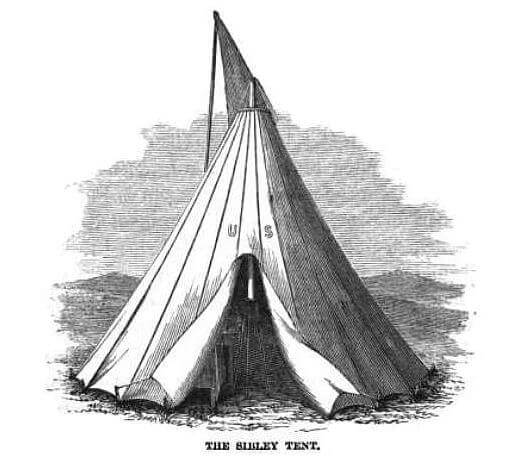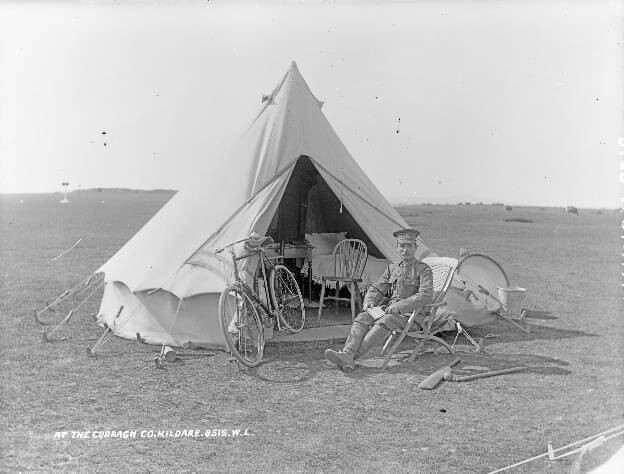
The controversy over what to call these popular glamping tents these days is mostly a branding problem. Marketing a product is pretty hard if people don’t know what to call it. It’s every marketing teams deep-seated fantasy to have their brand name become as recognizable as the thing they are selling: Band-Aid, Velcro, ChapStick...adhesive bandage, hook and loop roll, lip balm. You know which you’re more likely to Google.
Conical, or “cone-shaped” tents are not unique to the Native Americans. Conical tents have been in use by Native peoples around the Northern Hemisphere in varying designs for thousands of years. Whether you call it a Tipi, Chum, Goahti, Lavvu, Kohte, Nentsi, or any other number of names, a conical shape is the most aerodynamic in terms of shedding rain, snow, and wind. These shapes are also the most heat, space, and weight efficient designs, offering the highest margin of tensile strength with the smallest amount of structural support.
Sibley Tent and Bell Tent haven’t been common terms for over 100 years. The UK is the only place where the term ‘bell tent’ is widely used and understood. Most people in other countries don’t know what to call them. In the US, the sibley or bell tent is commonly called a teepee, yurt, glamping tent, or simply canvas tent. None of these names are accurate but that’s ok, the terminology has yet to catch up with the popularity of the product.
If you call it a ‘Bell Tent’, you’re likely going to be up in arms over the ‘misclassification’ of Sibley Tents as Bell Tents. You will also likely favor the origin story that the tents evolved from Europe rather than the US.
Ever the heretics, CanvasCamp’s official position is to fuel this industry drama. This is a Bell Tent, which is a Sibley with side walls, which evolved from a Tipi.


A Sibley tent is made from canvas and has a conical shape. It has no side walls and resembles a tipi, which makes sense as Henry Hopkins Sibley got the idea from the Native American teepees of the Great Plains. A Sibley tent has no guy lines, a low entry, no defined porch, a stove hole and a fire pit.
Bell tents were originally used by the British cavalry, but unlike the Sibley, the Bell tent has sidewalls and guy lines, with these adaptations, the Bell tent has additional headroom and breathability. The Bell tent doesn’t have a fire pit inside the tent.


Conical, or “cone-shaped” tents are not unique to the Native Americans. Conical tents have been in use by Native peoples around the Northern Hemisphere in varying designs for thousands of years. Whether you call it a Tipi (Teepee), Chum, Goahti, Lavvu, Kohte, Nentsi, or another name, the conical tent is one of the most successful tent designs in history. A cone shaped tent is the most aerodynamic in terms of shedding rain, snow, and wind. These shapes are also the most heat, space, and weight efficient designs, offering the highest margin of tensile strength with the smallest amount of structural support. Read more about the History of the Tipi Tent on our blog.


The Original Sibley tent was patented in 1856 by a Federal Army Colonel, Henry Hopkins Sibley. While stationed at the Texas frontier from 1850-1854, Sibley developed an appreciation for the Native American tipi after visiting a Comanche village. Understanding the importance of tents in military campaigns, his original interpretation of the tipi had no side walls, a single center pole, and a vented “cap” from which smoke could escape, similar to the Scandinavian Lavvu. Drawing on the exceptional weather resistant design of the tipi, with a vastly reduced weight for easy transport, and a quick set up and break down time.
Possibly unknown to Sibley, a similar single-pole conical tent called a “Bell tent” (after it's bell-shape) was also in use by British Cavalry in 1855 during the Crimean wars, and may be dated as far back as the 9th century in Europe. Sibley is certainly credited with the invention of the single pole tipi that now bears his name. Whomever added short walls to the cone canopy is not well documented, but in doing so they would have invented the Bell tent. Better minds than ours should weigh in on whether it was based on Sibley’s design or independently evolved.
In accordance with an agreement made with the Department of War, Sibley would have received $5 for every tent they made. However, Sibley joined the Confederate States Army after the outbreak of the American Civil War and did not receive the royalty. The Federal Army used almost 44,000 Sibley tents by the end of the war. After Sibley's death, his relatives attempted unsuccessfully to collect the royalties.
Sibley vs Britain is a western-biased argument to begin with. There must have been some prehistoric man or woman dragging a tipi across a vast plane, setting up camp after an exhausting day, and declaring…”Dude, I’m just using one pole tonight”.
The Sibley and Bell tents continued to evolve over time. Proportion, pole arrangements, arched entrances, side walls, and vents were experimented with to give the design increased functionality. With the advent of synthetic materials, floors and windows were added to meet the needs of the modern canvas camping tent. Since 2005, CanvasCamp has pioneered the evolution of this unique design with elegant design features, advanced canvas treatments, and innovative accessories to make the finest modern canvas tent currently conceived. Appropriately named the Sibley Bell Tent.
We call it a Sibley Bell Tent because we incorporate aspects of all designs to make a high-caliber canvas tent that’s easy to set up, durable and looks simple, yet luxurious.
- Easy to Pitch
The Sibley Bell tent can be easily pitched by one person. Check out our how to pitch a CanvasCamp tent video!
- Easy to transport
When folded up inside the CanvasCamp tent bag, the Sibley Bell tent is portable and ready to go where you go.
- Space
From our most compact tent, the 300 Ultimate with 7m2 (75ft²) of floor space and 190cm (6’3”) of height, to the palatial Sibley 600 Twin Pro with 20.5m2 (220 ft²) and 300cm (9’10”) of height, there’s plenty of room inside our Sibley Bell tents to move around.
- Breathable
Since our tents are made of breathable canvas, you’ll never feel like you’re suffocating like in a synthetic tent. Not to mention, on warm days you can roll up the sides to let the breeze pass through.
- Durable
When properly maintained and stored, our CanvasCamp tents last longer than most celebrity marriages!
- Weatherproof
Our canvas is treated for water resistance and our groundsheet is water and vapor impermeable. Additionally, the weave of the cotton fibers create a natural waterproofing by swelling and employing the surface tension of water to bead and encourage run off.
- Stove Compatibility
Our CanvasCamp Sibley Bell tents can be outfitted with a stove for the colder months as long as you use the appropriate stove jack depending on the size of the stove pipe. Check out the tent stoves we offer and stay warm when it gets chilly out.
Sibley Bell Tents are popular as glamping tents because they look good with their classic design, are spacious enough to fit all you lavish gear and are a happy medium for those who want to get outside but don’t want to rough it. Most of all, because they’re adaptable. That’s why Sibley Bell Tents are the tents of choice for festivals, weddings, pop up glamping rentals and high fashion events.


From the Native American teepee to the Sibley tent and the Bell tent - the Sibley Bell tent has evolved into a high quality, durable, luxurious tent known by many names and for many uses.
Check out our product line of Sibley Bell tents and get outdoors!